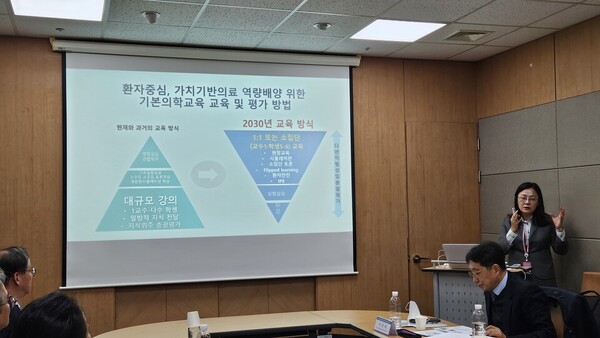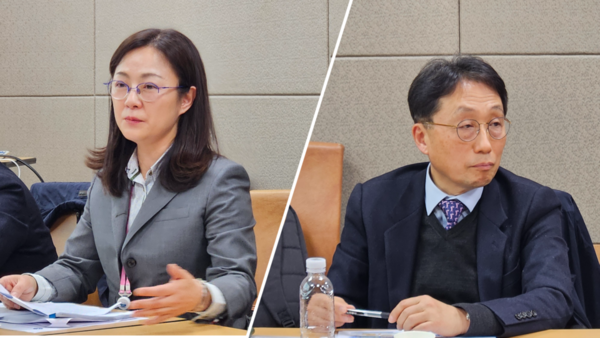Medical school professors repeatedly point out that the government's decision to increase in the medical school enrollment quota will compromise the quality of medical education.
Some experts have gone so far as to express concerns that such actions could regress medical education by a century.
As part of its series of public debates on the medical student increase, the National Assembly Research Service (NARS) dealt with issues to improve medical students’ education and specialty training on Wednesday.

At the debate, medical professors said if the number of medical students increases by 2,000, it will be impossible to produce “the doctors that society requires.” Medical education has recently changed from gathering students in large lecture halls to teaching simple clinical knowledge, and the sudden increase will add to the confusion in the field.
"We have strived to prepare a competency-based curriculum and foster doctors required by society. Last year, the enforcement decree of the Higher Education Act was revised to integrate the pre-med and the main medical department, trying to make the reorganization of disciplines an opportunity for innovation in medical education," Professor Lee Young-mee of the Department of Medical Education at Korea University said. "However, the expansion of medical students has destroyed all of that."
Professor Lee said that as society expects doctors to provide “patient-oriented medical care,” uniform education based on large-scale lectures cannot train doctors as society requires. She stressed that “clinical medicine education” is needed to develop the essential competencies for patient-centered care.
"Doctors who respond to society's and patients' needs should not only cure patients' illnesses but also contribute to reducing medical costs and empathize with patients," she said. "However, most patients do not like medical students coming to the hospital and participating in medical students’ training. For hospitals, patients are customers, so many medical students graduate almost without meeting a real patient."
Professor Lee explained that through clinical medicine education, medical schools prepare scenarios befitting various examples, such as foreign patients or cases needing social support. These are followed by debates, presentations, and simulation training using standardized patients.
To implement it, she said, professors and students need to be placed one-on-one or in a ratio of five to six students per professor, and facilities, such as simulation centers and seminar rooms, are also needed.
"Sometimes, we must secure up to 10 professors for a single case. It is impossible to teach this content in a lecture-style education," she said. “However, due to limited resources, even this is currently not possible at all grades."
If the government wants to require doctors to serve the public interest, it should invest in educating medical students and trainee doctors.
"Medical service serves both private and public interests. However, the government prohibits junior doctors from resigning, saying, how can public goods quit?” Professor Lee said. “If the government wants to emphasize the public interest aspect of physicians, it should invest financial resources into training doctors. So far, it has been like ‘blowing one’s nose even without touching it.’ If we want to expand the public good, we must do something different.”
Lee continued, “Please help us produce medical professionals who can compete with global medical experts instead of letting it go back 100 years. It’s not about turf war, and the expansion of medical school admission quota will have a negative impact. We professors are all worried about this. Please help us reach a quick resolution."
‘It's difficult to recruit professors and build capacity for 2025 academic year’

The professors at the debate viewed that it would be difficult for medical schools to build the capacity to educate the increased number of students by the time they start accepting new students in 2025."Chungbuk National University School of Medicine has 120 professors for a student quota of 40. They will have to teach 200 students starting next year. Can the school expand its faculty to 400 or 500? It is questionable whether there will be people going to become professors," Professor Lee said. "The government says there will be time to expand facilities and manpower as new students are admitted as pre-med students. However, one-third of pre-med classes are now held in medical schools. Who will teach those students?"
Professor Emeritus Lee Jong-tae of Inje University College of Medicine also said, "The number of students in regional medical schools has increased significantly, but private medical schools are very poor because there is no government support. In the case of one medical school, I heard that they couldn't hire an anatomy professor, so they hired one from a veterinary school. The government has to invest a lot of money."
However, it is difficult to convince or explain the negative impact of increasing the number of medical school students in medical education with concrete figures.
"I think it would be more persuasive if we talked about the specifics of what would be worse if we increased the number of students by 2,000," Lee said. "However, what we can say now is that we are currently training doctors who can treat and care for patients from doctors who only look at diseases, and if we increase the number of students by 2,000, we will inevitably regress to training doctors who only look at diseases again."
Lee continued, "I don't think anyone can explain it with specific numbers. But that's the experience of someone who has trained in the field. Even if you don't show the difference quantitatively, you're still recognizing (the expert's opinion) based on implicit knowledge and experience."
Meanwhile, the National Assembly Research Service maintained that it cannot take a clear position on medical school enrollment and the resultant healthcare void. It has held two roundtable discussions on the expansion of medical students, including one on the scale and method of increasing the number of doctors and short- and long-term measures to strengthen regional and essential medical care.
"One of NARS’s functions is to change executive policies and mediate conflicts between stakeholders," said Lee Man-woo, director of the Social and Cultural Research Office. The NARS is not a conflict mediator but rather a supporter through policy research necessary for conflict-mediating legislators' work. It is difficult for us to take a direct stance on this.
Related articles
- Resigned trainee pediatricians demand urgent policy to revive essential healthcare
- New leader of doctors' group asks President Yoon to fire health minister
- Trainee doctors remain distrustful of government’s conciliatory gesture
- Senior doctors nationwide rush to resign en masse
- Ophthalmologist dies in Busan, possibly due to overwork
- Korea to block resigned trainee doctors from getting US medical license
- President Yoon nails down his push to increase medical school admission quota by 2,000 seats
- Government to review proposal to postpone med student increase for 1 year: vice minister

